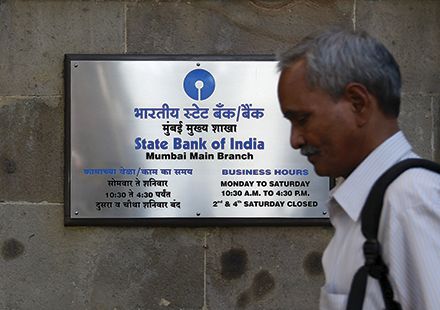State Bank of India is contemplating a range of funding options after setting onshore and offshore benchmarks for Indian bank capital.
Fresh from raising close to US$1bn in aggregate from Additional Tier 1 bonds in the domestic and international markets, State Bank of India is confident that investor appetite for yield will allow it to fund its future growth requirements as credit demand looks set to pick up next year.
“Today, investors are chasing high yields and the only market which is providing decent yields with relatively low credit risk is India,” said C Venkat Nageswar, deputy managing director for global markets at India’s largest public-sector bank.
SBI is looking to issue another Rs40bn (US$597m) of AT1 capital in the offshore rupee (Masala), US dollar or domestic bond markets, depending on market conditions and investor interest, Nageswar told IFR.
“We would like to price the Masala bonds at 8.5%–8.85%. Even if it is 10bp more than rupee bonds, it is still okay with me because we get to diversify the investor base.”
While Masala AT1 plans are on hold pending “clear guidelines” from the Reserve Bank India, the bank has sold subordinated capital in dollars and onshore rupees in the third quarter – with the local market proving by far the more receptive.
Onshore demand
SBI raised Rs21bn at 9% from AT1s that were entirely placed with Yes Bank in early September. Later that month, it placed another Rs25bn with HDFC Mutual Fund at 8.75%.
“The rate of interest on bank deposit is very low and investors have a few options to deploy their money, such as corporate bonds, G-sec and AT1,” Nageswar said.
The 10-year government benchmark is hovering at 6.82% and bank deposits are offering returns in the range of 7.0%–7.5%.
Investors buying AT1s from public sector banks are taking comfort from government ownership and low default risk.
“Holding SBI bonds is nearly as good as holding sovereign bonds. The capital adequacy ratio was at 14% in June and would have gone up further since the latest round of capital raising,” said Nageswar.
AT1 issuances in the domestic market are expected to continue after the RBI, under new governor Urjit Patel, cut interest rates by 25bp on October 4.
The central bank was also set to announce guidelines by the end of October allowing banks to classify a chunk of soured debt as standard assets, potentially easing capital pressures and improving valuations.
The move will further support AT1 issuance and reduce pressure on the government to inject capital.
In recent months, a slowdown in bank lending has given banks some breathing space to replenish capital.
“As a rule of thumb, if GDP is growing at 7%, then credit growth is going to be 2x, but now credit growth will be lower at around 1.5x,” Nageswar explained. With manufacturing stuck in low gear, “credit demand is only seen in the retail space, a little bit in the small and medium enterprise space, and mid-corporate [lending] is slowly picking up.”
However, SBI expects credit growth to improve to 15% in the next financial year from 11%–12% in the current year ending next March.
Once this happens, and as the clock ticks towards the deadline to implement more stringent Basel III requirements, SBI will need to look further afield to raise funds.
Public sector banks have to raise at least Rs1trn to meet the Basel III capital norms by March 2019, according to estimates by rating agencies.
With equity sales mostly out of the question due to low valuations and government ownership, Icra estimates that as much as Rs700–900bn of that capital requirement can be met by issuing AT1 instruments.
Frosty reception
Given the amounts at stake, only the offshore market has the necessary depth to fill the gap. SBI dipped its toes into the US dollar market in mid-September, but it received a much frostier response than at home.
The bank sold US$300m AT1s at 5.5% only to see the bonds drop close to a point in secondary market, before progressively recovering in the weeks since.
While market sources have faulted aggressive pricing for the poor showing, SBI maintains it raised the amount it always had in mind at a good price and says it had to overcome the hurdle posed by India’s relatively onerous loss-absorption rules.
“RBI’s trigger points [for loss-absorption] at 6.125% [of core equity Tier 1 after March 2019] are more stringent than the Basel requirement at 5.125%. So, that adversely affected the pricing of our AT1,” said Nageswar.
In addition, SBI’s international rating is constrained by the Baa3/BBB–/BBB– sovereign rating for India.
The nascent offshore rupee bond market is another avenue that the bank is keen to tap.
“Investors have expressed huge interest in Masala bonds. This appetite I have seen even in London and other regions as well,” Nageswar said.
“We would like to price the Masala bonds at 8.5%–8.85%. Even if it is 10bp more than rupee bonds, it is still okay with me because we get to diversify the investor base,” he said.
SBI, which accounts for over 20% of India’s total bank loans and deposits and has been designated a domestic systemically important bank (D-SIB), saw net profit fall 32% in the April-June quarter, while total non-performing loans rose to 6.9% of all loans as of end-June, from 6.5% in the previous quarter.
To view all special report articles please click here and to see the digital version of this report please click here.
To purchase printed copies or a PDF of this report, please email gloria.balbastro@thomsonreuters.com.



